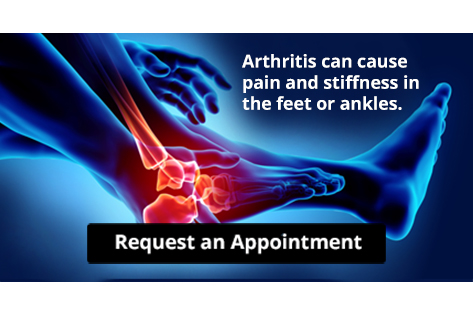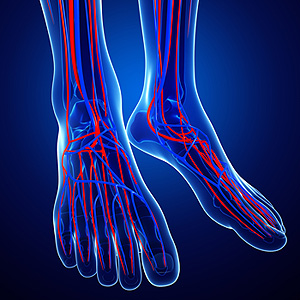Blogs
Types of Corns
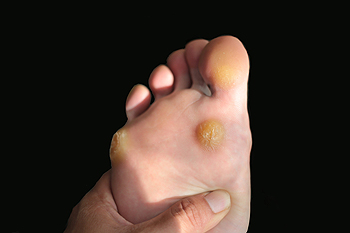 People who have experienced a corn on their feet are often aware of the pain and discomfort they can cause. Corns can develop between the toes, which are referred to as soft corns. The pain may be severe while walking in shoes, and mild relief may be found when it is covered by a corn pad. Corns are often caused by wearing shoes that do not fit correctly, and the corn may diminish when proper footwear is worn. Corns that develop on top of the toes are known as hard corns, and can form as a result of friction that comes from the top of the foot rubbing against the top of the shoe. Corns can cause pain that can affect the structure of the feet, which is why it is suggested that you consult with a podiatrist who can properly remove any corns you may have, and guide you toward proper prevention.
People who have experienced a corn on their feet are often aware of the pain and discomfort they can cause. Corns can develop between the toes, which are referred to as soft corns. The pain may be severe while walking in shoes, and mild relief may be found when it is covered by a corn pad. Corns are often caused by wearing shoes that do not fit correctly, and the corn may diminish when proper footwear is worn. Corns that develop on top of the toes are known as hard corns, and can form as a result of friction that comes from the top of the foot rubbing against the top of the shoe. Corns can cause pain that can affect the structure of the feet, which is why it is suggested that you consult with a podiatrist who can properly remove any corns you may have, and guide you toward proper prevention.
If you have any concerns regarding your feet and ankles, contact Dr. Dean D. Hinners of Illinois. Our doctor will treat your foot and ankle needs.
Corns: What Are They? and How Do You Get Rid of Them?
Corns can be described as areas of the skin that have thickened to the point of becoming painful or irritating. They are often layers and layers of the skin that have become dry and rough, and are normally smaller than calluses.
Ways to Prevent Corns
There are many ways to get rid of painful corns such as wearing:
- Well-fitting socks
- Comfortable shoes that are not tight around your foot
- Shoes that offer support
Treating Corns
Treatment of corns involves removing the dead skin that has built up in the specific area of the foot. Consult with Our doctor to determine the best treatment option for your case of corns.
If you have any questions please feel free to contact one of our offices located in Metropolis and Eldorado, IL . We offer the newest diagnostic and treatment technologies for all your foot and ankle needs.
Read more about Everything You Need to Know About CornsHow to Tell If You’ve Developed Gout
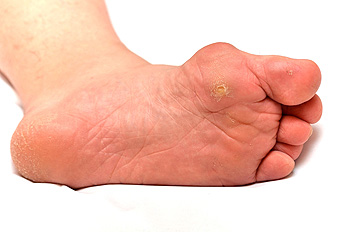 Gout, an inflammatory form of arthritis, can be recognized by observing extreme swelling and redness on the side of one’s big toe. Other common symptoms may include a tender sensation when the affected area is touched, as well as a sharp, burning, or hot pain on the side of the big toe. Gout can be caused by high levels of uric acid and poor blood circulation. This condition is often inherited, and is common among diabetic patients, people who have high blood pressure or who are obese. Gout can be managed and treated by drinking plenty of water, icing the affected area, changing your diet to reduce purine levels, and by wearing compression socks. For a proper diagnosis and recommended plan for treatment, it’s suggested thank you consult with a podiatrist.
Gout, an inflammatory form of arthritis, can be recognized by observing extreme swelling and redness on the side of one’s big toe. Other common symptoms may include a tender sensation when the affected area is touched, as well as a sharp, burning, or hot pain on the side of the big toe. Gout can be caused by high levels of uric acid and poor blood circulation. This condition is often inherited, and is common among diabetic patients, people who have high blood pressure or who are obese. Gout can be managed and treated by drinking plenty of water, icing the affected area, changing your diet to reduce purine levels, and by wearing compression socks. For a proper diagnosis and recommended plan for treatment, it’s suggested thank you consult with a podiatrist.
Gout is a foot condition that requires certain treatment and care. If you are seeking treatment, contact Dr. Dean D. Hinners from Illinois. Our doctor will treat your foot and ankle needs.
What Is Gout?
Gout is a type of arthritis caused by a buildup of uric acid in the bloodstream. It often develops in the foot, especially the big toe area, although it can manifest in other parts of the body as well. Gout can make walking and standing very painful and is especially common in diabetics and the obese.
People typically get gout because of a poor diet. Genetic predisposition is also a factor. The children of parents who have had gout frequently have a chance of developing it themselves.
Gout can easily be identified by redness and inflammation of the big toe and the surrounding areas of the foot. Other symptoms include extreme fatigue, joint pain, and running high fevers. Sometimes corticosteroid drugs can be prescribed to treat gout, but the best way to combat this disease is to get more exercise and eat a better diet.
If you have any questions please feel free to contact one of our offices located in Metropolis and Eldorado, IL . We offer the newest diagnostic and treatment technologies for all your foot and ankle needs.
Read more about GoutPlantar Warts Can Be Treated!
Are Cracked Heels a Common Ailment?
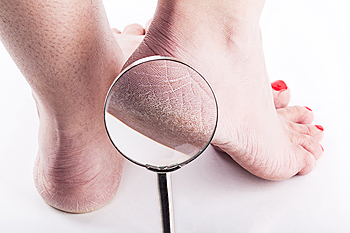 Cracked heels is a common condition that many people worldwide may experience. It may develop as a result of wearing shoes that have an open back, or from standing for extended periods of time throughout the day. In severe cases, this ailment may produce pain and discomfort, especially while walking or running. Some patients find mild relief when the feet are washed in warm water and dried thoroughly, followed by applying a good moisturizer. It may also be beneficial to drink plenty of water and to protect the heels by wearing comfortable shoes. If you have cracked heels, it’s suggested that you consult with a podiatrist who can offer the proper treatment options for this condition.
Cracked heels is a common condition that many people worldwide may experience. It may develop as a result of wearing shoes that have an open back, or from standing for extended periods of time throughout the day. In severe cases, this ailment may produce pain and discomfort, especially while walking or running. Some patients find mild relief when the feet are washed in warm water and dried thoroughly, followed by applying a good moisturizer. It may also be beneficial to drink plenty of water and to protect the heels by wearing comfortable shoes. If you have cracked heels, it’s suggested that you consult with a podiatrist who can offer the proper treatment options for this condition.
Cracked heels are unsightly and can cause further damage to your shoes and feet. If you have any concerns, contact Dr. Dean D. Hinners from Illinois. Our doctor can provide the care you need to keep you pain-free and on your feet.
Cracked Heels
Cracked heels appear unappealing and can make it harder for you walk around in sandals. Aside from looking unpleasant, cracked heels can also tear stockings, socks, and wear out your shoes. There are several methods to help restore a cracked heel and prevent further damage.
How Do You Get Them?
Dry skin is the number one culprit in creating cracked heels. Many athletes, walkers, joggers, and even swimmers suffer from cracked heels. Age and skin oil production play a role to getting cracked heels as well.
Promote Healing
Over the counter medicines can help, especially for those that need instant relief or who suffer from chronic dry feet.
Wear Socks – Wearing socks with medicated creams helps lock in moisture.
Moisturizers – Applying both day and night will help alleviate dryness which causes cracking.
Pumice Stones – These exfoliate and remove dead skin, which allows for smoother moisturizer application and better absorption into the skin.
Change in Diet
Eating healthy with a well-balanced diet will give the skin a fresh and radiant look. Your body responds to the kinds of food you ingest. Omega-3 fatty acids and zinc supplements can also revitalize skin tissue.
Most importantly, seek professional help if unsure how to proceed in treating cracked heels. A podiatrist will help you with any questions or information needed.
If you have any questions, please feel free to contact one of our offices located in Metropolis and Eldorado, IL . We offer the newest diagnostic and treatment technologies for all your foot care needs.
Read more about Solutions for Cracked HeelsAre Flat Feet Painful?
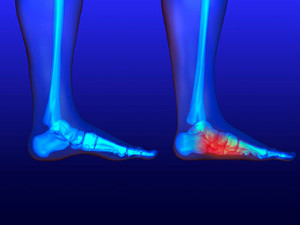 Factors that indicate you may have flat feet are often noticeable while standing on the floor. The arch of the foot will appear absent, or extremely low. The arch typically provides a spring to the step, and is helpful in distributing the weight of the body across the legs and feet. Flat feet may develop from birth, genetic factors, or from a possible foot or ankle injury. Common symptoms that can be associated with this condition may include foot pain, and the arch area may become swollen, as well as the calves. If you have flat feet, it is suggested that you are under the care of a podiatrist who can recommend specific stretching techniques. These may be helpful in alleviating some of the pain and discomfort that can come with this condition.
Factors that indicate you may have flat feet are often noticeable while standing on the floor. The arch of the foot will appear absent, or extremely low. The arch typically provides a spring to the step, and is helpful in distributing the weight of the body across the legs and feet. Flat feet may develop from birth, genetic factors, or from a possible foot or ankle injury. Common symptoms that can be associated with this condition may include foot pain, and the arch area may become swollen, as well as the calves. If you have flat feet, it is suggested that you are under the care of a podiatrist who can recommend specific stretching techniques. These may be helpful in alleviating some of the pain and discomfort that can come with this condition.
Flatfoot is a condition many people suffer from. If you have flat feet, contact Dr. Dean D. Hinners from Illinois. Our doctor will treat your foot and ankle needs.
What Are Flat Feet?
Flatfoot is a condition in which the arch of the foot is depressed and the sole of the foot is almost completely in contact with the ground. About 20-30% of the population generally has flat feet because their arches never formed during growth.
Conditions & Problems:
Having flat feet makes it difficult to run or walk because of the stress placed on the ankles.
Alignment – The general alignment of your legs can be disrupted, because the ankles move inward which can cause major discomfort.
Knees – If you have complications with your knees, flat feet can be a contributor to arthritis in that area.
Symptoms
- Pain around the heel or arch area
- Trouble standing on the tip toe
- Swelling around the inside of the ankle
- Flat look to one or both feet
- Having your shoes feel uneven when worn
Treatment
If you are experiencing pain and stress on the foot you may weaken the posterior tibial tendon, which runs around the inside of the ankle.
If you have any questions please feel free to contact one of our offices located in Metropolis and Eldorado, IL . We offer the newest diagnostic and treatment technologies for all your foot and ankle needs.
Read more about FlatfootWearing High Heels While Working
 Many patients experience foot pain at the end of their working day. This may be a result of wearing shoes that do not fit correctly, or it may come from standing for extended periods of time throughout the day. Some work environments require high heels to be worn. If this is true for you, it may be beneficial to wear the lowest heel that is acceptable in the work environment, in addition to frequently stretching the calf muscles during the day. Additionally, it may be favorable to wear shoes that are made of breathable materials, and to alternate them with another pair, as this may help to avoid discomfort. If you would like additional information about how to protect your feet while working, please schedule an appointment with a podiatrist.
Many patients experience foot pain at the end of their working day. This may be a result of wearing shoes that do not fit correctly, or it may come from standing for extended periods of time throughout the day. Some work environments require high heels to be worn. If this is true for you, it may be beneficial to wear the lowest heel that is acceptable in the work environment, in addition to frequently stretching the calf muscles during the day. Additionally, it may be favorable to wear shoes that are made of breathable materials, and to alternate them with another pair, as this may help to avoid discomfort. If you would like additional information about how to protect your feet while working, please schedule an appointment with a podiatrist.
While working on the feet, it is important to take the proper care of them. For more information about working on your feet, contact Dr. Dean D. Hinners from Illinois. Our doctor will treat your foot and ankle needs.
Working on Your Feet
Standing on your feet for long periods of time can cause stress and pain in your feet. Your whole body may experience change in terms of posture, back pain, bunions, callouses and or plantar warts. There are ways to avoid these conditions with proper foot care, smart choices and correct posture.
Positive Changes
Negative heeled shoe – Choosing this shoe type places the heel slightly lower than the ball of the foot. These are great for overall foot health. Find shoes that fit you correctly.
Go barefoot – Our feet were not designed to be enclosed for all hours of the day. Try to periodically expose your feet to air.
Eliminate Pain
Foot Exercises – Performing simple exercises, incorporating yoga and doing stretches are beneficial. This will allow increased blood flow to the area and muscles of the foot.
Achilles tendon – Stretching the foot out flat on the floor will relax the calf muscles and tendon. These exercises can be performed almost anywhere. Make sure you add these exercises to your daily regimen.
With a little bit of this information and knowing more about foot health, you will notice changes. Foot stretches and proper footwear will help with pain and prevent further issues.
If you have any questions please feel free to contact one of our offices located in Metropolis and Eldorado, IL . We offer the newest diagnostic and treatment technologies for all your foot and ankle needs.
Read more about How to Handle a Long Work Day on Your FeetPossible Causes of Bunions
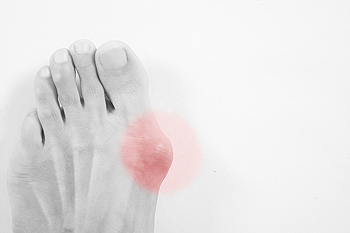 Patients who have developed bunions are often aware of the pain and discomfort they may cause. A bunion appears as a bony protrusion on the side of the big toe, and it may be difficult to wear shoes. Some of the symptoms that are associated with bunions can consist of redness and swelling on the bottom of the big toe, and the second toe may overlap the big toe. Genetic factors may play a significant role in developing bunions, in addition to wearing shoes that do not have adequate room for the toes to move freely in. Some patients may have existing medical conditions that can increase the risk of obtaining a bunion, such as flat feet, or neuromuscular conditions. It may be beneficial to wear custom made orthotics which may help to relieve some of the pressure that bunions can cause. If you have developed a bunion, please consult with a podiatrist who can help you to manage this ailment.
Patients who have developed bunions are often aware of the pain and discomfort they may cause. A bunion appears as a bony protrusion on the side of the big toe, and it may be difficult to wear shoes. Some of the symptoms that are associated with bunions can consist of redness and swelling on the bottom of the big toe, and the second toe may overlap the big toe. Genetic factors may play a significant role in developing bunions, in addition to wearing shoes that do not have adequate room for the toes to move freely in. Some patients may have existing medical conditions that can increase the risk of obtaining a bunion, such as flat feet, or neuromuscular conditions. It may be beneficial to wear custom made orthotics which may help to relieve some of the pressure that bunions can cause. If you have developed a bunion, please consult with a podiatrist who can help you to manage this ailment.
If you are suffering from bunions, contact Dr. Dean D. Hinners of Illinois. Our doctor can provide the care you need to keep you pain-free and on your feet.
What Is a Bunion?
A bunion is formed of swollen tissue or an enlargement of boney growth, usually located at the base joint of the toe that connects to the foot. The swelling occurs due to the bones in the big toe shifting inward, which impacts the other toes of the foot. This causes the area around the base of the big toe to become inflamed and painful.
Why Do Bunions Form?
Genetics – Susceptibility to bunions are often hereditary
Stress on the feet – Poorly fitted and uncomfortable footwear that places stress on feet, such as heels, can worsen existing bunions
How Are Bunions Diagnosed?
Doctors often perform two tests – blood tests and x-rays – when trying to diagnose bunions, especially in the early stages of development. Blood tests help determine if the foot pain is being caused by something else, such as arthritis, while x-rays provide a clear picture of your bone structure to your doctor.
How Are Bunions Treated?
- Refrain from wearing heels or similar shoes that cause discomfort
- Select wider shoes that can provide more comfort and reduce pain
- Anti-inflammatory and pain management drugs
- Orthotics or foot inserts
- Surgery
If you have any questions, please feel free to contact one of our offices located in Metropolis and Eldorado, IL . We offer the newest diagnostic and treatment technologies for all your foot care needs.
Read more about What Are Bunions?Arthritis Can Cause Pain in the Feet and Ankles
Where Is the Plantar Fascia?
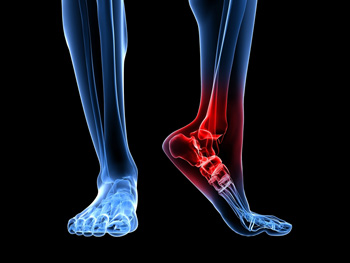 The portion of tissue that is found on the bottom of the foot is called the plantar fascia. It connects the heel to the toes, and helps to provide flexibility to the foot while walking and running. When this band of tissue becomes inflamed as a result of an injury or from overuse, the condition plantar fasciitis may develop. The symptoms that are generally associated with this condition can include severe pain and discomfort in the heel and surrounding area, and this pain may be worse in the morning after arising. Some patients find mild relief when the affected foot is rolled on a cold bottle, as this may be helpful in relaxing the affected muscles. If you suffer from plantar fasciitis, it is strongly suggested that you are under the care of a podiatrist who can properly treat this condition.
The portion of tissue that is found on the bottom of the foot is called the plantar fascia. It connects the heel to the toes, and helps to provide flexibility to the foot while walking and running. When this band of tissue becomes inflamed as a result of an injury or from overuse, the condition plantar fasciitis may develop. The symptoms that are generally associated with this condition can include severe pain and discomfort in the heel and surrounding area, and this pain may be worse in the morning after arising. Some patients find mild relief when the affected foot is rolled on a cold bottle, as this may be helpful in relaxing the affected muscles. If you suffer from plantar fasciitis, it is strongly suggested that you are under the care of a podiatrist who can properly treat this condition.
Plantar fasciitis can be very painful and inconvenient. If you are experiencing heel pain or symptoms of plantar fasciitis, contact Dr. Dean D. Hinners from Illinois. Our doctor can provide the care you need to keep you pain-free and on your feet.
What Is Plantar Fasciitis?
Plantar fasciitis is the inflammation of the thick band of tissue that runs along the bottom of your foot, known as the plantar fascia, and causes mild to severe heel pain.
What Causes Plantar Fasciitis?
- Excessive running
- Non-supportive shoes
- Overpronation
- Repeated stretching and tearing of the plantar fascia
How Can It Be Treated?
- Conservative measures – anti-inflammatories, ice packs, stretching exercises, physical therapy, orthotic devices
- Shockwave therapy – sound waves are sent to the affected area to facilitate healing and are usually used for chronic cases of plantar fasciitis
- Surgery – usually only used as a last resort when all else fails. The plantar fascia can be surgically detached from the heel
While very treatable, plantar fasciitis is definitely not something that should be ignored. Especially in severe cases, speaking to your doctor right away is highly recommended to avoid complications and severe heel pain. Your podiatrist can work with you to provide the appropriate treatment options tailored to your condition.
If you have any questions please feel free to contact one of our offices located in Metropolis and Eldorado, IL . We offer the newest diagnostic and treatment technologies for all your foot and ankle needs.
Read more about Plantar FasciitisPainful Injuries to the Achilles Tendon
 There are noticeable symptoms that exist with an Achilles tendon injury. These can include pain near your heel, soreness after arising in the morning, and difficulty flexing or pointing the foot. Additionally, there may be a “popping” sound that happens at the time of the injury. The Achilles tendon connects the calf muscles to the heel, and can be significantly uncomfortable if an injury occurs. Consistent stress to the tendon may come from wearing shoes that do not fit correctly, participating in a new sporting activity, or exercising on uneven surfaces. Moderate relief may be found when the affected foot is elevated, as this may help to alleviate a portion of the swelling. Some patients find it can be beneficial to wear orthotics to help relieve discomfort as the healing process occurs. If you have endured an injury to your Achilles tendon, it is strongly advised that you consult with a podiatrist.
There are noticeable symptoms that exist with an Achilles tendon injury. These can include pain near your heel, soreness after arising in the morning, and difficulty flexing or pointing the foot. Additionally, there may be a “popping” sound that happens at the time of the injury. The Achilles tendon connects the calf muscles to the heel, and can be significantly uncomfortable if an injury occurs. Consistent stress to the tendon may come from wearing shoes that do not fit correctly, participating in a new sporting activity, or exercising on uneven surfaces. Moderate relief may be found when the affected foot is elevated, as this may help to alleviate a portion of the swelling. Some patients find it can be beneficial to wear orthotics to help relieve discomfort as the healing process occurs. If you have endured an injury to your Achilles tendon, it is strongly advised that you consult with a podiatrist.
Achilles tendon injuries need immediate attention to avoid future complications. If you have any concerns, contact Dr. Dean D. Hinners of Illinois. Our doctor can provide the care you need to keep you pain-free and on your feet.
What Is the Achilles Tendon?
The Achilles tendon is a tendon that connects the lower leg muscles and calf to the heel of the foot. It is the strongest tendon in the human body and is essential for making movement possible. Because this tendon is such an integral part of the body, any injuries to it can create immense difficulties and should immediately be presented to a doctor.
What Are the Symptoms of an Achilles Tendon Injury?
There are various types of injuries that can affect the Achilles tendon. The two most common injuries are Achilles tendinitis and ruptures of the tendon.
Achilles Tendinitis Symptoms
- Inflammation
- Dull to severe pain
- Increased blood flow to the tendon
- Thickening of the tendon
Rupture Symptoms
- Extreme pain and swelling in the foot
- Total immobility
Treatment and Prevention
Achilles tendon injuries are diagnosed by a thorough physical evaluation, which can include an MRI. Treatment involves rest, physical therapy, and in some cases, surgery. However, various preventative measures can be taken to avoid these injuries, such as:
- Thorough stretching of the tendon before and after exercise
- Strengthening exercises like calf raises, squats, leg curls, leg extensions, leg raises, lunges, and leg presses
If you have any questions please feel free to contact one of our offices located in Metropolis and Eldorado, IL . We offer the newest diagnostic tools and technology to treat your foot and ankle needs.
Read more about Achilles Tendon InjuriesMore...
Promptly Treating Wounds on the Feet
 Many diabetic patients are aware of the importance of promptly treating existing foot wounds. There may be serious complications if foot wounds are not treated, which may cause pain and discomfort. Some of the wounds on the feet that can be dangerous to the health of a diabetic patient can include cuts, blisters, or severely dry skin that may result in cracked heels. There are noticeable signs an infection may have developed. These can consist of extreme pain, swelling, and pus may appear surrounding the affected area. Additionally, some patients may experience a high temperature, swollen glands, or a general feeling of being unwell. If you have wounds on your feet, it is strongly advised that you are under the care of a podiatrist who can treat existing wounds.
Many diabetic patients are aware of the importance of promptly treating existing foot wounds. There may be serious complications if foot wounds are not treated, which may cause pain and discomfort. Some of the wounds on the feet that can be dangerous to the health of a diabetic patient can include cuts, blisters, or severely dry skin that may result in cracked heels. There are noticeable signs an infection may have developed. These can consist of extreme pain, swelling, and pus may appear surrounding the affected area. Additionally, some patients may experience a high temperature, swollen glands, or a general feeling of being unwell. If you have wounds on your feet, it is strongly advised that you are under the care of a podiatrist who can treat existing wounds.
Wound care is an important part in dealing with diabetes. If you have diabetes and a foot wound or would like more information about wound care for diabetics, consult with Dr. Dean D. Hinners from Illinois. Our doctor will assess your condition and provide you with quality foot and ankle treatment.
What Is Wound Care?
Wound care is the practice of taking proper care of a wound. This can range from the smallest to the largest of wounds. While everyone can benefit from proper wound care, it is much more important for diabetics. Diabetics often suffer from poor blood circulation which causes wounds to heal much slower than they would in a non-diabetic.
What Is the Importance of Wound Care?
While it may not seem apparent with small ulcers on the foot, for diabetics, any size ulcer can become infected. Diabetics often also suffer from neuropathy, or nerve loss. This means they might not even feel when they have an ulcer on their foot. If the wound becomes severely infected, amputation may be necessary. Therefore, it is of the upmost importance to properly care for any and all foot wounds.
How to Care for Wounds
The best way to care for foot wounds is to prevent them. For diabetics, this means daily inspections of the feet for any signs of abnormalities or ulcers. It is also recommended to see a podiatrist several times a year for a foot inspection. If you do have an ulcer, run the wound under water to clear dirt from the wound; then apply antibiotic ointment to the wound and cover with a bandage. Bandages should be changed daily and keeping pressure off the wound is smart. It is advised to see a podiatrist, who can keep an eye on it.
If you have any questions, please feel free to contact one of our offices located in Metropolis and Eldorado, IL . We offer the newest diagnostic and treatment technologies for all your foot care needs.
Read more about Wound CarePossible Symptoms of PAD
A medical condition that is referred to as peripheral artery disease (PAD) can have severe symptoms that often include muscle cramping in the legs and feet. Patients who exercise may notice the pain diminishes when activities are stopped. This can be a result of decreased blood flow. Additional symptoms of this ailment may consist of wounds on the feet or toes that may not heal properly, consistent leg pain, and the feet may feel cold for the majority of the day. It may also be indicative of heart issues, which is why it is important to be properly diagnosed. If you have a numbing or tingling sensation in your feet, it is advised that you consult with a podiatrist who can properly treat this condition.
Peripheral artery disease can pose a serious risk to your health. It can increase the risk of stroke and heart attack. If you have symptoms of peripheral artery disease, consult with Dr. Dean D. Hinners from Illinois. Our doctor will assess your condition and provide you with quality foot and ankle treatment.
Peripheral artery disease (PAD) is when arteries are constricted due to plaque (fatty deposits) build-up. This results in less blood flow to the legs and other extremities. The main cause of PAD is atherosclerosis, in which plaque builds up in the arteries.
Symptoms
Symptoms of PAD include:
- Claudication (leg pain from walking)
- Numbness in legs
- Decrease in growth of leg hair and toenails
- Paleness of the skin
- Erectile dysfunction
- Sores and wounds on legs and feet that won’t heal
- Coldness in one leg
It is important to note that a majority of individuals never show any symptoms of PAD.
Diagnosis
While PAD occurs in the legs and arteries, Podiatrists can diagnose PAD. Podiatrists utilize a test called an ankle-brachial index (ABI). An ABI test compares blood pressure in your arm to you ankle to see if any abnormality occurs. Ultrasound and imaging devices may also be used.
Treatment
Fortunately, lifestyle changes such as maintaining a healthy diet, exercising, managing cholesterol and blood sugar levels, and quitting smoking, can all treat PAD. Medications that prevent clots from occurring can be prescribed. Finally, in some cases, surgery may be recommended.
If you have any questions, please feel free to contact one of our offices located in Metropolis and Eldorado, IL . We offer the newest diagnostic and treatment technologies for all your foot care needs.
Read more about Peripheral Artery DiseaseSigns You May Have Developed Neuropathy
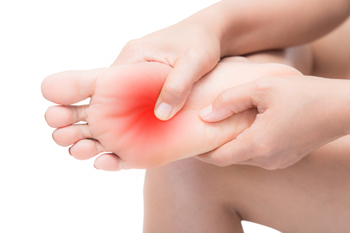 Neuropathy is a condition that affects the feet, specifically causing them to lose feeling. This can be incredibly dangerous, especially if you have developed a serious foot condition and can not feel the symptoms of it. Neuropathy may also alter the shape of your foot. Your arch may be raised, your toes can begin to bend downward, and the bones at the ball of your foot may protrude outward. When the shape of the foot changes, it in turn changes its overall function as well. To keep your feet comfortable, you may want to look into wearing shoes with extra support. Other signs that indicate you may have developed neuropathy include sensations of numbness, stinging, burning, and stabbing aches and pains. Hypersensitivity, as well as dry or cracked skin may develop due to neuropathy. In order to receive a proper diagnosis, and a suggested plan for treatment, we recommend you consult with a podiatrist for professional care.
Neuropathy is a condition that affects the feet, specifically causing them to lose feeling. This can be incredibly dangerous, especially if you have developed a serious foot condition and can not feel the symptoms of it. Neuropathy may also alter the shape of your foot. Your arch may be raised, your toes can begin to bend downward, and the bones at the ball of your foot may protrude outward. When the shape of the foot changes, it in turn changes its overall function as well. To keep your feet comfortable, you may want to look into wearing shoes with extra support. Other signs that indicate you may have developed neuropathy include sensations of numbness, stinging, burning, and stabbing aches and pains. Hypersensitivity, as well as dry or cracked skin may develop due to neuropathy. In order to receive a proper diagnosis, and a suggested plan for treatment, we recommend you consult with a podiatrist for professional care.
Neuropathy
Neuropathy can be a potentially serious condition, especially if it is left undiagnosed. If you have any concerns that you may be experiencing nerve loss in your feet, consult with Dr. Dean D. Hinners from Illinois. Our doctor will assess your condition and provide you with quality foot and ankle treatment for neuropathy.
What Is Neuropathy?
Neuropathy is a condition that leads to damage to the nerves in the body. Peripheral neuropathy, or neuropathy that affects your peripheral nervous system, usually occurs in the feet. Neuropathy can be triggered by a number of different causes. Such causes include diabetes, infections, cancers, disorders, and toxic substances.
Symptoms of Neuropathy Include:
- Numbness
- Sensation loss
- Prickling and tingling sensations
- Throbbing, freezing, burning pains
- Muscle weakness
Those with diabetes are at serious risk due to being unable to feel an ulcer on their feet. Diabetics usually also suffer from poor blood circulation. This can lead to the wound not healing, infections occurring, and the limb may have to be amputated.
Treatment
To treat neuropathy in the foot, podiatrists will first diagnose the cause of the neuropathy. Figuring out the underlying cause of the neuropathy will allow the podiatrist to prescribe the best treatment, whether it be caused by diabetes, toxic substance exposure, infection, etc. If the nerve has not died, then it’s possible that sensation may be able to return to the foot.
Pain medication may be issued for pain. Electrical nerve stimulation can be used to stimulate nerves. If the neuropathy is caused from pressure on the nerves, then surgery may be necessary.
If you have any questions, please feel free to contact one of our offices located in Metropolis and Eldorado, IL . We offer the newest diagnostic and treatment technologies for all your foot care needs.
Read more about Neuropathy
